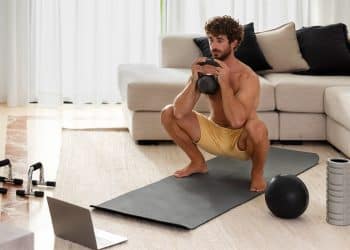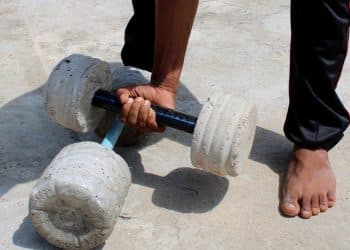Cable pulley machines are among the most versatile pieces of training equipment in a gym. You could train virtually every muscle group using the cable pulley, including the chest, shoulders, triceps, biceps, forearms, back, abs, quads, hamstrings, glutes, and calves.
Before we get into the nitty-gritty of DIY cable pulley machines, let’s understand what cable pulleys are, what makes them so great, and why you should consider building one for your home gym.
What is a Cable Pulley Machine?
While cable pulley machines come in different shapes and sizes, a standard commercial cable pulley machine consists of a rectangular, vertically oriented steel frame about 3 meters (10 feet) wide and 2 meters (6.5 feet) high.
Another popular iteration of the cable pulley machine is the functional trainer. Functional trainers are usually 1.2 meters (4 feet) wide and 2 meters (6 feet) high. Cable pulley machines have built-in selectorized weight stacks attached to a handle using a cable and pulley system.
Difference Between Free Weights and Cables
Commercial gyms usually have a line of people waiting for their turn on the cable machine during rush hours, whereas the free weight section is deserted. Have you ever wondered why that is?
Cable machines keep constant tension on the target muscle throughout the entire range of motion, irrespective of the movement plane, which is something not possible with free weights like dumbbells on barbells. For example, the cable chest flye is one of the most popular cable exercises; however, replicating this exercise with dumbbells is virtually impossible.
Level Up Your Fitness: Join our 💪 strong community in Fitness Volt Newsletter. Get daily inspiration, expert-backed workouts, nutrition tips, the latest in strength sports, and the support you need to reach your goals. Subscribe for free!
Why is that, you ask? Resistance profile.
The resistance profile of free weights changes with respect to gravity. During bicep dumbbell curls, the resistance is highest during concentrics (upward phase) when you lift the weight against gravity; there is no tension on your biceps when your lower arm is perpendicular to the floor, and the resistance decreases during eccentrics (lowering phase).
Conversely, the resistance profile of the cable pulley machine stays consistent throughout the range of motion, allowing peak muscle contraction at different points throughout the ROM, thus biasing hypertrophy.
What else? If you’ve been following our DIY gym equipment series (you should, if you already aren’t), you’ll know that building training equipment is not easy. It requires a decent amount of work, time, and craftsmanship. However, the DIY cable pulley machine is different. You can get most of the tools necessary for building a DIY cable pulley machine on Amazon for fairly cheap. Plus, you can build a DIY cable pulley system within 15 minutes.
Although you’d be paying a fraction of what you’d pay for a commercial cable pulley machine, it won’t hurt your training experience. More on the benefits of the DIY cable pulley system later in this article.
I’ll take you over the four best DIY cable pulley systems in this article. You could use the system that works best for you according to your current setup. However, I’m sure you’ll want to work up to the more advanced setup as you gain more training experience and realize the effectiveness of this training tool.
4 DIY Cable Pulley System Ideas You Can Build at Home
Here are the four DIY cable pulley systems to add variety to your training regimen:
#1 Junkyard DIY Cable Pulley System
The first DIY cable pulley system on this list is for folks who don’t have a gym setup and don’t want to invest in dedicated training equipment. For this pulley system, you only need access to a high pole where you can anchor the cable pulley. A pull-up bar in a park or a basketball or football pole are viable options for this setup.
Materials:
- Pliers with wire cutters
- Lighter
- One pulley
- One nylon rope (ensure the rope is thin enough to fit through the pulley and sturdy enough to hold heavy weights)
- 1-foot PVC or metal pipe (for the handle)
- 3 feet galvanized wire
- One S-shaped iron hook
- One carabiner
- Weights
Steps:
Follow this six-step DIY cable pulley system setup:
Step One — Ready the Handle
Begin by readying the cable pulley’s handle. For this, cut the galvanized wire into a 1-foot length to wrap it around your PVC or metal pipe thrice, and screw the untied end using a plier to secure the pipe. Tie the loose ends into a loop using the plier. This will give you a straight handlebar with a loop.
Step Two — Knot it Up
Use a lighter to melt one end of the nylon rope. Tie that end into a knot to secure it. Tie another knot right behind the melted knot, but keep it loose. Attach the loop to one end of the S-shaped iron hook and tighten it so it doesn’t move around. The melted end should keep the knots securely in place.
Step Three — Prepare Your Pulley and Attach it to an Elevated Structure
Thread the remaining 2 feet of galvanized wire through the pulley’s loop. Use a ladder to tie the pulley around a sturdy, tall pole like a pull-up bar. Wrap the 2-foot wire around the object as many times as possible and thread the wire through the pulley’s loop each time. Use a plier to wrap the ends of the wire and tie them.
Step Four — Add the Rope and Handlebar
Once your pulley is stable, thread the untied end of the nylon rope through the top of the pulley. Then, melt this end of the rope using a lighter and tie a knot. This knot will serve two purposes. Keep the rope in the pulley, and be used to attach the carabiner and the handlebar.
Step Five — Add Weights
Attach a heavy object to the end of the rope on the S-shaped hook, like a suitcase, water, or rock-filled bucket.
Step Six — Test
Use a lightweight to test the sturdiness of this DIY cable pulley setup. Feel free to pull on the galvanized wire and use a jerking motion during your demo reps.
#2 Doorway Pull-Up Bar DIY Cable Pulley System
Most people who train at their homes have a pull-up bar. You can use the DIY cable pulley system listed below on a doorway pull-up bar or a dedicated pull-up bar in your garage or basement.
I recommend getting a cable rope attachment (or a straight handlebar) and an actual weight plate for this setup. Alternatively, you could use a dumbbell, kettlebell, or other heavy objects like suitcases or backpacks. Suitcases and backpacks are great, as they allow you to change the load on the machine and tweak your training volume.
Weights might cost you a little money upfront, but they will last you a lifetime and can add to your training experience. Furthermore, investing in training equipment makes you more likely to stick to your workout regimen.
Some people might find this DIY cable pulley system more convenient than the last one if they have a pull-up bar at home.
Materials:
- One Swivel pulley
- One Pull-up bar
- Weight plate, dumbbell, or other object
- 30 feet of rope
- One handlebar or rope attachment
- One carabiner (optional)
Steps:
Here is how to make this DIY cable pulley system:
Step One — Setup a Pull-Up Bar
If you don’t have a pull-up bar already, you must get one. Are you confused about which pull-up bar you should get? Don’t worry. We have got you covered. Check out this comprehensive guide about the best pull-up bars for your home gym. This review piece includes everything from a wall-mounted pull-up bar to a multi-station.
Step Two — Attach the Pulley to the Pull-Up Bar
Cut a 1-foot piece of rope and thread it through the swivel pulley’s top loop. You can get these pulleys on Amazon for less than $5. Tie the rope and the pulley around the pull-up bar. Make a double knot to ensure the rope doesn’t come undone during your set. Also, feel free to invest in a higher-quality rope and pulley for safety.
Step Three — Complete Your Setup
Depending on the height of your pull-up bar, cut an appropriate length of rope so you can perform your desired exercises using a full range of motion. Tie one end of the rope to a weight plate, dumbbell, or bucket. Tie the other end in a knot and melt it using a lighter. Make another knot and add a carabiner. Alternatively, you could thread the rope through your handlebar and tie it into a knot. Ensure that both your knots are secure enough to hold the weight and the dumbbell throughout the exercise.
Step Four — Test
Test your pulley setup using a lightweight. Also, keep a cushion or a chair under the weights to ensure it doesn’t damage your floor if the rope breaks or you lose control.
A major downside to using this DIY cable pulley system is that you might have to take down the setup after each use, especially if you’re using it in your room’s doorway. You could slide it to the side if you have set it up on your garage gym’s pull-up bar, but it will be an obstacle nonetheless. For maximum efficiency, you want a system that involves minimal friction.
#3 Double Pulley System
We are getting into the more advanced setups with this DIY cable pulley system. Most commercial cable machines have six pulleys on either side. On the other hand, basic lat pull-down machines can have up to four pulleys attaching the handle to the weight stack.
This is not by accident. More pulleys can add to the stability of your cable pulley system. While single pulley DIY systems get the job done, they are not the most heavy-duty or smooth by any means.
Many lifters complain about weight instability while lifting heavier weights on the DIY pulleys, as they might have to use a little momentum. Jerking on the bar on a single-pulley setup can make the weights swing like a pendulum, increasing your risk of injury.
Using a double pulley system for your DIY setup will improve its stability and give you a smoother experience. Although it might increase your setup cost and maintenance requirements, a dual pulley system is much more efficient than a single one.
Since the next two setups are more advanced, you’ll need a squat rack for them. That said, feel free to check out these DIY cable pulley systems and figure out a way to integrate them into your existing setup, embracing the DIY spirit of these projects.
Materials:
- Two Pulleys
- Four carabiners
- 15 feet cable
- Soft loop tie-down straps
- Straight handlebar
- Loading pin (I told you we are going heavy-duty for this one)
Steps:
Check out the step-by-step guide to build the DIY double pulley system:
Step One — Set up the Tie-Down Straps
By the end of this, you’ll realize how easy it is to build a stable DIY cable pulley system and how you’ve been missing out on crazy muscle pumps for no reason all this long.
Begin by threading the tie-down strap through one of the holes in the top connecting beam of your squat rack on the front side. Repeat the process on the rear end. You could also do this on the rack’s side since they are usually closer and will require a smaller rope.
Step Two — Attach the Carabiners and Pulleys
Loop one end of the tie-down through the other end and attach a carabiner to the strap. This will secure the tie-down and allow you to add the pulleys. Repeat on the rear end. Pull on the pulleys to eliminate any slack in the tie-down straps.
Step Three — Add the Cable
Thread the cable through the pulleys and attach a carabiner to each end. On the rear end, attach a loading pin to the carabiner. Attach a straight handlebar to the front of the cable pulley, and voila, your DIY cable pulley system is good to go.
Step Four — Test
As always, you must test your homemade gym setup with lightweight to ensure everything works smoothly and it can handle the weights you plan to throw at it.
Two Bonus Steps
First, since you are using a squat rack for this setup, the possibilities are unlimited. For example, you could set up a flat bench under the front cable pulley, attach strap safeties to the rack at your knee level, and secure your thighs under it to perform lat pulldowns.
Alternatively, you could add another pulley to the bottom of your squat rack and connect it to the pulleys on the top to use it for exercises like the seated cable row. You must use the sidebars for this setup.
Credits: Danteredgravestrength.com
#4 Cable Crossover DIY Cable Pulley System
The three DIY cable pulley systems explained above are great for exercises that require a single pulley stack, like triceps pushdowns, lat pulldowns, and straight arm pulldowns. However, you cannot perform one of the most popular cable exercises on this setup — the cable chest flyes.
Level Up Your Fitness: Join our 💪 strong community in Fitness Volt Newsletter. Get daily inspiration, expert-backed workouts, nutrition tips, the latest in strength sports, and the support you need to reach your goals. Subscribe for free!
There are two ways of setting up a double pulley system to perform the chest flyes. You could double the first two setups mentioned above. However, you would need two weight stacks for it, and as explained earlier, a single pulley system can be unstable, and doubling that for the chest flyes could add to the trouble and lead to strength and muscle imbalances. You could use the DIY cable pulley system number three and double it (use four pulleys), but it would be an extensive setup, and require a lot of time to set up and tear down after each workout.
Here is a clever DIY cable pulley system workaround that will allow you to perform exercises like the cable chest flyes using two pulleys without compromising stability:
Materials:
- Socket wrench
- Two swivel pulleys (Using a pulley with a swivel will give you more angles of resistance.)
- Four carabiners
- Four cable thimbles
- Four cable clamps
- Eight soft-loop tie-down straps
- Two 10-foot lengths of vinyl-covered wire rope
- Loading pin
- Weights
- Power rack
Steps:
Step One — Make a Loop at the End of Each Cable
Thread the vinyl-covered wire rope through the loop end of two clamps. Circle the wire rope and thread it back through both clamp loops. Ensure the cable clamps have a loop at the top and a screw-on nut at the bottom and that the circle at the end of the wire is big enough to insert a cable thimble.
The thimble will prevent your wire from wearing down quickly. Insert a thimble into the circle of wire. Pull the wire through the clamp loops to tighten it around the thimble. Use a wrench to tighten the nuts and bolts.
Step Two — Insert a Swivel Pulley
Now, thread the other end of the rope wire through a swivel pulley and position it in the cable’s center. Repeat step one on the other end to make a loop and secure it. Repeat steps one and two on the second wire.
Step Three — Attach the Pulleys to Your Power Rack
Tie a soft-loop tie-in to each end of a pull-up bar on your power rack or in the 1-inch holes of your rack. Attach a carabiner to both tie-ins and then attach the swivel pulley’s top loop to it. Ensure the cables are hanging at your head height on the front side. Attach a D-handle bar to the thimbles on the front side of the cable.
Step Four — Add Weights
With the front side of the pulley ready, it’s time to put together the rear end. Add a lightweight to a loading pin and loop thimbles on the rear end through the pin’s loop. Alternatively, you could add a carabiner to the loading pin and then attach the thimbles.
Attaching both cables to a single loading pin ensures the weights are stable throughout the exercise. You could attach the cables to different loading pins, but most people find that the weights start swinging while lifting heavy.
Alternatively, if you want multiple loading pins, you can use a two-pulley setup, as explained in DIY project number three. This will add stability to your DIY cable pulley system and allow you to train one side of your body at a time.
Attachments For the DIY Cable Pulley System
Cable attachments boost your cable pulley system’s utility, allowing you to train multiple muscle groups using the same setup from different angles. Here are the cable pulley attachments you should consider investing in:
D-Handle
D-handle bars are an excellent cable attachment for performing unilateral exercises, such as the triceps pushdown, biceps curls, single-arm chest presses or flyes, and single-arm lat pulldowns. They are an absolute must if you go with the fourth DIY cable pulley setup.
Rope Handle
A rope handle attachment allows you to change your hand placement during an exercise, which changes the movement’s line of pull and, subsequently, the resistance profile. It is a must-have if you are trying to bring up your triceps.
Lat Pulldown Bar
The lat pulldown bar is straight in the middle and angles toward the end. Holding the bar toward the end on the lat pulldown can help ensure better muscle engagement. Alternatively, folks on a tight budget can use it for exercises like the biceps curl, triceps pushdown, and straight-arm lat pulldown.
Ankle Cuffs
Ankle cuffs are an underrated cable attachment. You can use them to target the glutes on exercises like cable kickbacks or the hamstrings with single-leg standing leg curls. You could also tie them around your wrists to eliminate your grip strength on exercises like the side lateral raise.
Things To Consider While Setting Up a DIY Cable Pulley System
Here are the things to consider before you build yourself a DIY cable pulley:
Purpose
Your DIY cable pulley setup will depend on your training objectives and experience. For example, beginners and people with limited means can use the first two DIY ideas detailed in this article; more experienced exercisers who have a home gym with a power rack should opt for the third and fourth DIY cable pulley systems.
Also, folks who plan to lift heavier weights on the DIY cable pulley system should use the two-pulley system, as explained in the third DIY project in this article. It will make your lifts smoother and reduce the risk of the setup breaking down during your workout.
Pulley
Irrespective of your training objective or preferred exercise, you’ll need a pulley to set up your DIY cable pulley system.
Most people choose swivel pulleys when setting up a DIY cable pulley system. Although swivel pulleys are inexpensive and have excellent weight capacity (usually 650 pounds), they are not the most efficient. Since they lack bearings, swivel pulleys are not smooth and can be noisy, especially if you don’t grease or oil them regularly.
I recommend getting pulleys that have bearings. These will make your training experience smoother and are silent. However, these might cost a little extra compared to swivel pulleys, but the functionality and convenience are worth the price.
Cables
Get cables with a sheath to protect the metal. Metal cables are usually cheaper than insulated cables but are more susceptible to breaking on heavy use. Clear vinyl-coated cables are the go-to choice for DIY cable pulley systems.
Tips For Using DIY Cable Pulley System
Use the following tips to maximize the utility of your homemade cable pulley:
Make Thigh Support
Once you have a cable pulley system set up, you’d likely want to do the cable lat pulldown on it. However, lifting heavy weights on this exercise while seated on the floor can be inconvenient and can transfer the tension from your lats to other muscle groups. To combat this, you can set up the pulley machine on your squat rack and adjust the safety bands at a height so you can slide your thighs under them while seated on a flat bench.
Experiment with the Pulley Position
Different setups demand different pulley positions. Basement power racks are usually shorter than garage gym racks. A pulley set at 6 feet will target your muscles differently than a pulley set at 9 feet. You must find out what works out the best for you.
You should avoid pre-cutting your cables when dealing with a unique DIY pulley setup. Cut the cable only after determining the ideal height for the handle and the loading pin. This will prevent a lot of cable wastage.
Benefits of the DIY Cable Pulley System
Setting up a DIY cable pulley system has the following advantages:
Saves Time
Cable exercises usually require less time than free-weight exercises, as you don’t have to change the weights on the bar or look for the right set of dumbbells after each set. Plus, lifters usually recover faster between cable exercises than free weights. This makes cables an excellent tool for people with a jam-packed schedule.
Constant Tension on Target Muscles
As explained above, cables keep constant tension on the muscle throughout the range of motion, improving hypertrophic results. Furthermore, you can use them to train muscles from angles that are not possible using free weights. This ensures overall muscle development, helping improve your physique’s aesthetics.
Versatility
Contrary to what most people think, you can perform compound movements like the squat, overhead press, and bent-over rows using the cables. Additionally, cables are a very versatile training tool. Bodybuilders can use it for hypertrophy, and powerlifters, Olympic weightlifters, CrossFitters, and Strongmen can incorporate them into their training regimen as accessory exercises.
Beginner-Friendly
Cable exercises have a shallow learning curve, making them an excellent fit for beginners. Since most cable exercises involve a fixed movement trajectory, they can help establish a mind-muscle connection, which can carry over to other compound movements like the barbell back squat or dumbbell shoulder press.
Safety
Cables are among the most safe training equipment in a gym. You probably know someone who hurt himself while lifting dumbbells or barbells. However, how many people do you know who got injured using the cable machine?
Plus, bailing on a cable pulley exercise is much safer than bailing on a free-weight exercise. Failing a rep of a heavy barbell bench press can get ugly. On the flip side, most people train to muscle failure on the cable chest press.
Cost-Effective
The biggest complaint gym owners, especially garage gym owners, have with the cable pulley machines is that they can break the bank. However, you can build a high-quality DIY cable pulley system at home for under $50.
Drawbacks of a DIY Cable Pulley System
These are the cons of building a homemade cable pulley system:
Not Adjustable
One of the biggest differences between a commercial and DIY cable pulley system is that the former’s pulleys are adjustable and can be set at different heights to target your muscles from different angles, whereas the latter is usually fixed at one height setting. Some elaborate DIY cable pulley systems have a pulley set at the squat rack’s bottom and top, but that is about it.
You could also have multiple pulleys set up at different heights on a dedicated pole, but this option is not viable for folks with limited space in their home gyms. That said, the top and bottom settings are the most used height settings on a cable pulley machine. You won’t miss out on a lot by not having pulley height settings in the middle.
Regular Maintenance
Most people love training at a commercial gym because the equipment is always up to date and works smoothly. However, most aspiring home gym owners forget that there is a team dedicated to keeping the commercial gyms running in top shape.
Cable pulley systems require regular maintenance. Depending on your usage, you might have to oil the pulley weekly and change the cables every year. However, maintenance work doesn’t take a lot of time. Oiling the pulley takes 10 seconds, and changing the wire takes less than 10 minutes.
Disassembling
Unless you have a dedicated power rack or pull-up bar for your DIY cable pulley system, you’ll have to disassemble it after each use. While this doesn’t sound like much work, it can subconsciously make you want to avoid using the cable pulley.
FAQs
How much does a DIY cable pulley system cost?
The most advanced (number four) DIY cable pulley systems detailed in this article can be built for under $50, provided you already own a power rack. You can make it cost even less by using stuff you already own or tweaking the blueprint. However, you must ensure your design changes don’t hamper the setup’s structural integrity.
How often should I use the DIY cable pulley system?
How often you use the DIY cable pulley system will depend on your training program and objectives. While bodybuilders could use it on every training day, powerlifters, CrossFitters, weightlifters, and strongmen can incorporate them into their accessory work twice or thrice weekly.
Are DIY cable pulley systems safe?
Depending on the materials used and how you rig them up, DIY cable pulley systems can be very safe. That said, you should always do a test set on your DIY cable pulley system before adding your working weight to the loading pin.
Wrapping Up
The cable pulley is an incredibly effective training tool. However, commercial cable pulley machines can be costly and out of reach for most home gym owners.
This guide covers four DIY cable pulley systems you can build for under $50. Despite the low cost, these homemade setups are as effective as the commercial rigs. Beginners can start with the first two pulley systems detailed in this article, whereas more advanced lifters with a power rack in their home gym should opt for the third and fourth systems.
If you have any questions about the DIY cable pulley systems, drop them in the comments below, and we’ll be happy to help!








